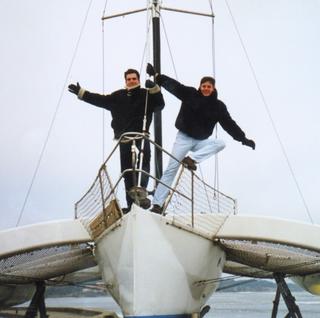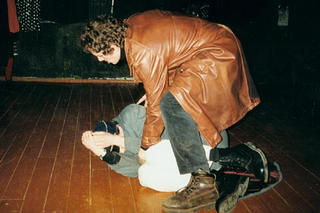And now, wearable technology. Call it wearware
Published:
28 March 2001 y., Wednesday
IBM in the jewelry business? Dutch electronics maker Philips selling street wear jackets? American high-tech start-ups creating space-age shades? Yes, yes and yes.
AT THIS YEAR’S CeBIT, IBM is showing studies of wearable computer add-ons such as a silver necklace with a hidden microphone, a lady’s display watch, earrings with speakers, and a ring whose elegant turquoise stone doubles as a nifty scroll-point mouse. Last year, Philips got together with jeans maker Levi Strauss for a limited edition of “wearable electronics garments” — jackets with a GSM mobile and an MP3 player in special pockets, with a small remote control on the front flap of the jacket and a microphone in the collar. The two devices work together, with the music turning itself off when you talk on the phone. (Available only in Europe, all 800 jackets quickly sold out). And about half a dozen companies are working on special glasses that use sophisticated optics to create screen-size images in front of your eyes.
One of the more intriguing developments in the industry is the push by some of the biggest companies into what’s become known as “wearables” — computers and accessories we can use on the go, while we’re busy doing other things. Wearables are already widespread in industry, where workers often need access to information but also need to keep their hands free. Workers building aircraft use head-mounted displays and speech-input devices for complex assembly tasks, which frees them from referring to lengthy manuals.
British Airways in experimenting with a crew of roaming check-in attendants at Heathrow’s Terminal 4, outfitted with keyboards on their forearms and a mini-display on a headset. Bell Canada sends its service technicians out to fix phone lines wearing a small computer in their pocket, a keyboard or touch-screen strapped to their wrist, and a helmet equipped with an optical display and a digital camera that beams pictures of trouble spots back to the maintenance center, wirelessly. Having quick access to precise instructions while they’re up on some telephone pole lets workers do more work in less time, says Daniel Butler, an executive at Fairfax, Virginia-based Xybernaut, maker of the wearable system BA and Bell Canada use.
Šaltinis:
NEWSWEEK
Copying, publishing, announcing any information from the News.lt portal without written permission of News.lt editorial office is prohibited.
The most popular articles
 Blue Card scheme to attract highly qualified migrants to the EU came closer on Tuesday 4 November.
more »
Blue Card scheme to attract highly qualified migrants to the EU came closer on Tuesday 4 November.
more »
 Young people from nine countries learn to sail and work together thanks to EU youth programme.
more »
Young people from nine countries learn to sail and work together thanks to EU youth programme.
more »
 Domestic violence is one of the most widespread violations of women's human rights across the world.
more »
Domestic violence is one of the most widespread violations of women's human rights across the world.
more »
 The European Parliament awards the Sakharov Prize every year to people who have dedicated their lives to defending human rights and mutual understanding.
more »
The European Parliament awards the Sakharov Prize every year to people who have dedicated their lives to defending human rights and mutual understanding.
more »
 The other week 200 young journalists from all over Europe descended on the European Parliament for workshops and debates.
more »
The other week 200 young journalists from all over Europe descended on the European Parliament for workshops and debates.
more »
 Risk assessment seen as key to safety at work. It was an accident waiting to happen.
more »
Risk assessment seen as key to safety at work. It was an accident waiting to happen.
more »
 The European Parliament's Sakharov Prize for Freedom of Thought has been awarded this year to Chinese political activist Hu Jia, EP President Hans-Gert Pöttering announced in Strasbourg today.
more »
The European Parliament's Sakharov Prize for Freedom of Thought has been awarded this year to Chinese political activist Hu Jia, EP President Hans-Gert Pöttering announced in Strasbourg today.
more »
 Microsoft Corp., internationally acclaimed actress Angelina Jolie, and more than 25 law firms and corporate law departments announced the formation of Kids in Need of Defense (KIND).
more »
Microsoft Corp., internationally acclaimed actress Angelina Jolie, and more than 25 law firms and corporate law departments announced the formation of Kids in Need of Defense (KIND).
more »
 The European Commission today welcomed the decision by the European Parliament to approve the proposal for a directive on Temporary Agency Work.
more »
The European Commission today welcomed the decision by the European Parliament to approve the proposal for a directive on Temporary Agency Work.
more »
 Hungary emerged among the three most miserable nations on a European happiness-sadness scale.
more »
Hungary emerged among the three most miserable nations on a European happiness-sadness scale.
more »